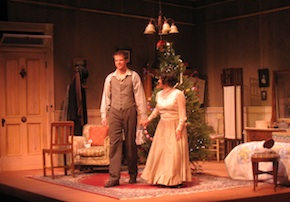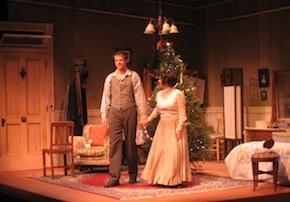
In what is now planned as an annual event, Hidden Valley Music Seminars, in Carmel Valley, opened a new production this past weekend of David Conte’s opera The Gift of the Magi. This charming setting, based on the popular O. Henry short story, also returned two veterans of Hidden Valley’s opera productions from decades past, designer/director Robert Darling and conductor Stewart Robertson. (Robertson conducted at Opera San José’s production of Carlson’s Anna Karenina in September 2010.)
The 65-minute, one-act opera got two back-to-back matinee performances Sunday in the intimate Hidden Valley theater, nestled in a bucolic, oak-studded swale between the two mountain ridges that define Carmel Valley’s allure. A full-house audience, mostly unfamiliar with the Bay Area composer’s work, came with high expectation and, judging by the postperformance buzz, were not disappointed.
Soprano Aimée Puentes led the cast as Della, wife to Gregory Gerbrandt’s Jim, impecunious newlyweds who have mutually agreed they cannot afford to buy Christmas gifts for one another. Like the O. Henry story, Nicholas Giardini’s libretto explores the full range of the couple’s conflicting emotions and rationalizations, in solo musings and dialogs, and with friends Maggie (Lisa van der Ploeg) and Henry (Krassen Karagiozov). Conte’s score follows apace with keen anticipation of actions and reactions.
The small orchestra (five strings, five winds, two brass, harp, and piano, led by Concertmaster Roy Malan) is replete with concertante solos, extravagant ensembles, and exquisite theatrical details. Darling has echoed orchestral commentaries in the actions of the characters on stage, in a look, pose, or gesture, with an unerring sense of timing.
Inevitably, the need to affirm their marriage in tangible form overwhelms the couple’s resolve, his to grace her long flowing hair with tortoiseshell combs she has admired in a shop window, hers to complement his inherited gold pocket watch with a matching chain. This requires unique sacrifice on both their parts, with famously ironic results. By telephone, Della enlists Maggie to implement her plan. (A muted trumpet stands in for Maggie’s chattering at the other end of the connection.) When Maggie arrives at the couple’s apartment, Della’s decision stirs up a tempest of doubt and anxiety between the two women. In a tender aria, Della sings of her deep affection for her husband.
For all its emotional angst, The Gift of the Magi remains at heart an intimate, personal story that deserves orchestral restraint.
Meanwhile, he has gone out to put his own plan into action. Following a brief orchestral interlude, which casts a ghostly glow on the three spectral magi who hover over the scene, Jim returns with his friend (brother?) Henry and a Christmas tree. On discovering how Jim could afford to buy the combs, Henry upbraids him furiously. Jim then gets his big solo, reflecting on his dead father and adored wife. When Jim and Della exchange gifts in the final scene, shock soon turns to renewed love and deeper understanding. The three magi then intone a brief “chorale” (borrowed from the San Francisco Conservatory recording of the work).
As with O. Henry, both Giardini and Conte follow tried-and-true formulas. I could can see bits of Gianni Schicchi and La Bohème through this scrim and hear sounds familiar in the works of Samuel Barber and Gian Carlo Menotti — an obvious pair-up with Amahl and the Night Visitors — and also of Henry Mollicone, another master of the short opera in tonal musical language.
Yet, for all the work’s immediate appeal and its vivacious orchestration, there’s an overall mismatch that suggests some revision is in order. A fine line separates complement from competition. In its high degree of instrumental detail, Conte’s score calls attention to itself and, too often, away from the actors singing on stage. This is not the only opera that leans toward that description. Weber’s Euryanthe and Respighi’s La fiamma, for example, provide splendid music that leaves their respective librettos to fend for themselves.
For all its emotional angst, The Gift of the Magi remains at heart an intimate, personal story that deserves orchestral restraint. (It should be noted that the Hidden Valley orchestra plays to one side of the stage; there is no pit, which, as conductor Robertson reminds us, would undoubtedly alter its sonic impact.)
Darling scaled his set design, a thrust stage contained within two walls of the small apartment, to the space required, with costumes recalling 1906 San Francisco. In the square-shaped theater, the singers’ projection depended on the direction they were facing. (With nearly as much space above the overhead lighting grid as below, the room’s cathedral ceiling draws away more sound than it gives back.)
The principals, with careers that include the Bay Area, showed obvious professionalism both in their stage smarts and in their lyric singing. (Van der Ploeg deserves a nod for “most-hysterical in show.”) Also noteworthy was David Moodey’s lighting, warm or cool as the mood changed and featuring, at the finale, a projection of stars high overhead against the soaring ceiling.

